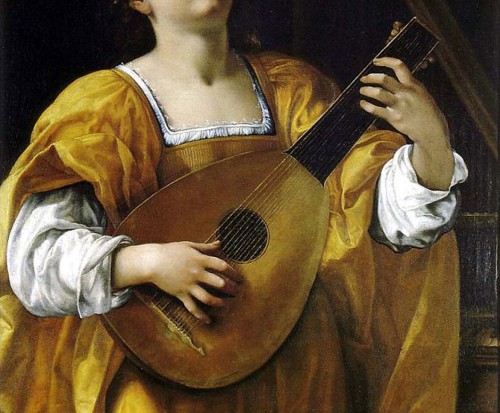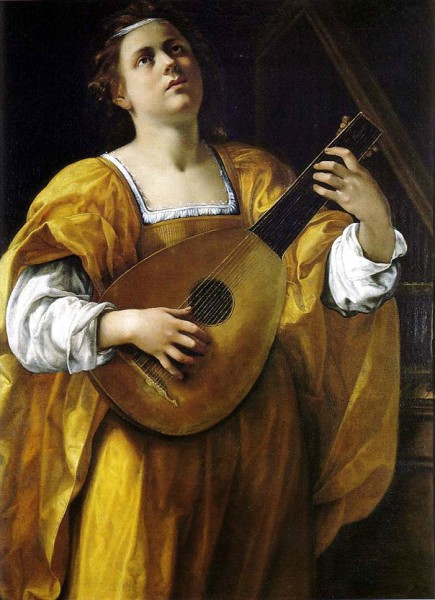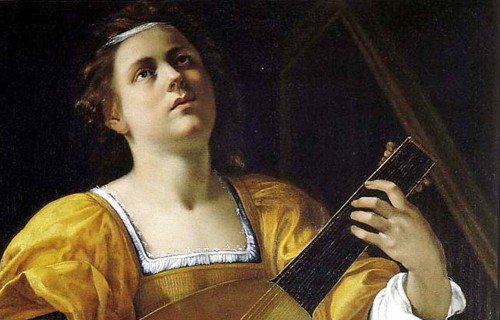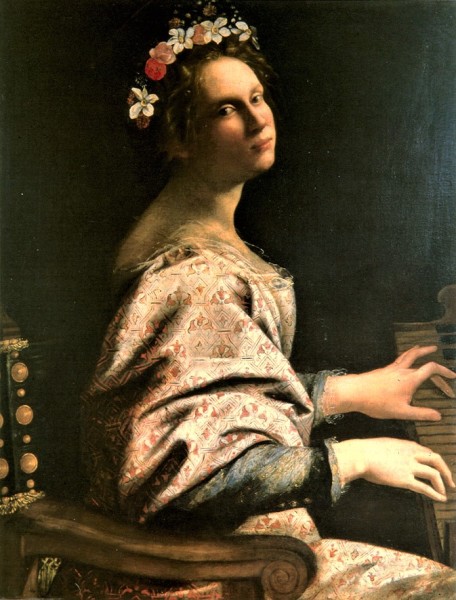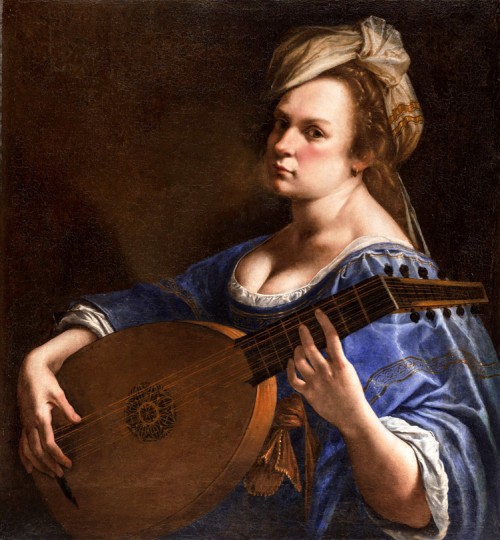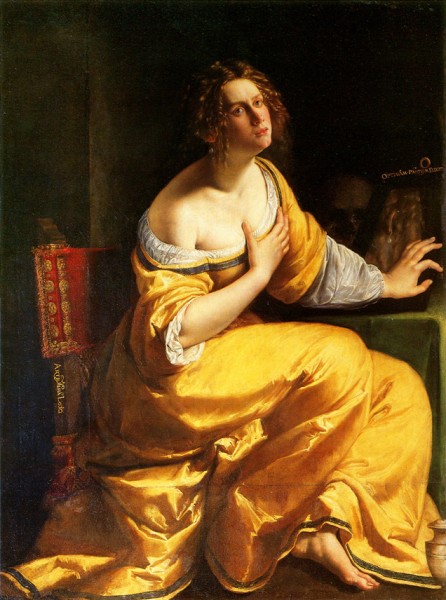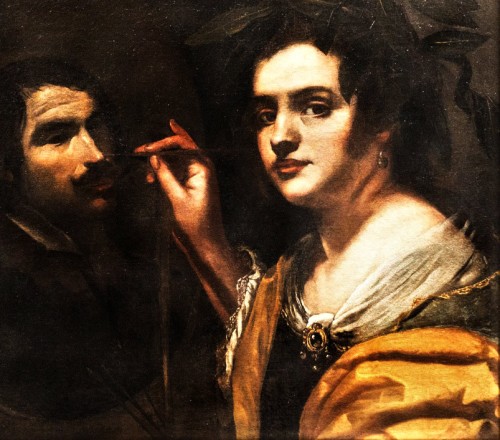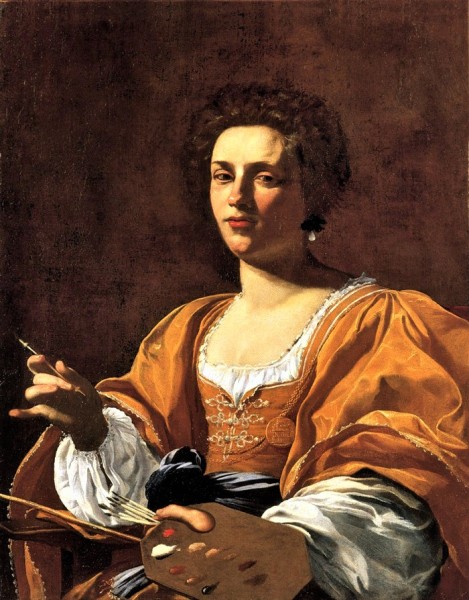Artemisia Gentileschi’s Saint Cecilia Playing the Lute – an autoportrait in the guise of a saint
According to a legend created in the V century (Passio sanctae Caeciliae) Cecilia had sworn to God to remain chaste. Forced to marry, she convinced her future husband Valerian to convert to Christianity and respect their marital abstinence. Until the late Middle Ages, Cecilia was presented, as every virgin-martyr would have been, with a palm, a crown, and a lily or a sword – the tool of her martyrdom. The connection with music did not come about until the saint had been named the patron of Church music, while organs (portable) had become her attribute, initially held in her hand, later shown as an instrument which she is playing. However, where did this association come from? Most likely from a badly translated fragment of the aforementioned Passio, in which Cecilia during her wedding was to play the organs to honor the Lord, when in reality this paragraph spoke of Cecilia who, not paying attention to the wedding music, intoned a song in her heart to honor Christ ((Cantantibus organis, Cecilia virgo in corde suo soli Domino decantabat – Eng. While the musical instruments played, the virgin Cecilia sang in her heart to God alone). Therefore, Cecilia did not sing while the organs were being played, but more appropriately despite them, she sang her own song not letting herself be distracted by the music. Despite this fact, the organs remained with her forever. During the late Middle Ages, the cult of saints was reborn, and they became the intercessors and patrons of individual professions and other organizations. This caused musicians and instrument makers to recall the fragment of the text, which talked about cantanibus organis, completely disregarding the context. In the XVI century, numerous associations and congregations were established with Cecilia as their patron, while the day of her martyrdom, became a holiday that was particularly celebrated by musicians. Musical works and paintings were created in her honor, to only mention the most famous one painted by Raphael (Saint Cecilia with the Saints, 1514) or the twelve-voice mass Cantibus organis, composed by Palestrina.

The cult of the saint reborn at the beginning of the XVII century, which was directly sparked by the discovery of her miraculously untouched by time corpse in the Church of Santa Cecilia on the Trastevere, caused a true renaissance of her popularity. At that time, in Rome, where she became one of the principal city patron saints, but also in other regions of Italy and Europe, many of her images were created. As the patron of Church music, she should have been presented with organs, but she was generally depicted with other instruments (harp, harpsichord, cello), and with the extremely fashionable lute. At some point, a specific metamorphosis of Cecilia took place. She lost the nimbus of sainthood and became the personification of music itself, an allegory, a muse, and an inspiration for musical art. In time she became only a pretext to paint attractive lute or violin players, who became a sought-after motif of interior decoration. Thus in this way, the walls of houses were filled with more and more secular, yet quasi-religious paintings. Our painting is one such work. If it had not been for the title or the barely visible organs at the side of the depicted woman, we would have never seen her as a saint.
Thanks to the recommendation made by Cesare Ripa in his Iconologia – a work which was a guide of iconographic motifs, and one that was readily used by the then artists, Cecilia was often depicted gazing towards the heavens. And this is how she was presented by Artemisia Gentileschi – intently listening to music, gazing upwards, as if in ecstasy, completely devoted to music. The painter did not use the typical in images of Cecilia nimbus of sainthood and showed her as more of a personification of music – art that enriches both the mind and soul of a man.
One of the cities in which the cult of saint Cecilia spread rapidly (besides Rome) was Florence – an important center of cultural life with the de Medici court attracting numerous artists of various professions. Cecilia was also (as the first woman) among the saint patrons of the Accademia degli Elevati established on the Arno in 1607. Soon the city was visited by the young Artemisia Gentileschi, looking for commissions and the support of the duke. In this way, she closed the door on a difficult and humiliating chapter of her life in Rome, where she became a victim of rape, fraud, and defamation. During the trial in which the rapist (Agostino Tassi) was sued by Artemisia’s father – Orazio Gentileschi, his daughter was tortured, slandered, and publically humiliated. Wanting to keep his daughter’s honor intact, and remove the label of a fallen woman, Orazio, two days after the verdict was passed, decided to marry off his daughter (for the appropriate sum) to a painter and his collaborator – Pietro Antonio Stiattesi – a handsome and vain youth, who agreed to marry Artemisia and leave Rome. Earlier Orazio wrote a letter to the Grand Duchess Christina of Lorraine (the mother of the Grand Duke of Tuscany, Cosma II) asking for the support of his daughter. In it, he described his daughter's great painting talent which she had developed under his watchful gaze. It must be added, that at that time women were forbidden to learn the profession of a painter, as opposed to men. Artemisia learned the secrets of the trade by watching her father, she mixed paints, prepared the canvas, sometimes painted the less important details of his compositions, and later fully independent works. In his workshop, she was also able to see the numerous images of Cecilia, that her father had painted.

At the beginning of 1613, the freshly married Artemisia along with her husband left Rome. And although it seemed that the marriage would not succeed, the initial years of the newlyweds’ stay in Florence passed harmoniously. In subsequent years, Artemisia gave birth to two boys (both died at a young age), then a girl known as Palmira. Thanks to her talent the painter quickly attracted faithful patrons, including Michelangelo the Younger – an art collector and a descendant of the great Michelangelo, as well as Duke Cosma II himself. This uneducated, half-orphan in time, gained savvy and knowledge, while her filled with strong emotions, and amazing colors, as well as exceptionally drawn paintings, gained renown. In Florence, she was also able to free herself from the painting mannerisms of her father and create her own style – decorative, dynamic, with a large dose of realism. It is enough to look at the exceptionally painted robes of her heroines – their exuberance, draping, and brightness of colors. The typical colors, which Gentileschi used, were a combination of ochre and bronze with crimson and gold with heavy blue.
The significance and renown of her talent were emphasized by the fact that she was accepted in 1616 – as the first woman – to the elite group of the Florentine Academy of the Arts of Drawing (Accademia del Disegno), which brought together the most renowned Italian artists. In this, she was aided by her uncle, the painter Aurelio Lomi, a member of the Academy, who at that time held the prestigious post of the consul of this institution. Artemisia also took on his surname (Artemisia Lomi), in this way cutting herself off from her father Orazio, but also her Roman past. In addition, she achieved something truly exceptional for those times – financial independence in the full sense of the word. She was able to make transactions, buy property, and even travel without the consent of her husband. She obtained lucrative commissions allowing for a comfortable life.
At the Florentine court, she met other talented women supported by duchess Christina. One of these was the musician and singer, who also tried her hand at painting – Arcangela Paladini. Artemisia immortalized her delicate beauty in one of several paintings devoted to Saint Cecilia (Saint Cecilia Playing the Harpsichord, 1620), private collections). Another artist, was the composer, creator of operas, and singer, Francesca Caccini, who also performed at the Florentine court solo, or accompanied by her siblings, singing and playing the lute. Perhaps, she was the direct inspiration for the artist, who once again painted Cecilia. Or perhaps Artemisia, as was customary at that time, played the lute herself, which can be seen in her self-portrait from about 1617, currently found in Minneapolis (Curtis Galleries).

We have become accustomed to looking at the work of Artemisia Gentileschi through the prism of rape and defamation, which she suffered. They were certainly a strong impulse to create the images of humiliated women, or those desiring revenge. An example of such a work is the dramatic and at the same time, gruesome painting Judith Slaying Holofernes (1613) inspired by the work of Caravaggio of the same title, which (as we can speculate) is a kind of a reckoning with the wrongs, which she had suffered. She willingly painted mythological and biblical heroines – strong and charismatic women (SS. Catherine, Magdalene, Judith, Cleopatra, Susanna, Galatea). More often than not their visages were the portrait of Artemisia herself. However, there existed another Artemisia – delicate and sensitive, and that is how we can see her in a painting dedicated to St. Cecilia. Apparently, the golden color of the saint’s robe was her favorite. The heavy, golden silk and satin can be seen in many of her paintings, and even in an image created by a fellow painter, Simon Vouet, in which Artemisia let herself be portrayed in a dress of golden color (Palazzo Blu, Pisa).
Saint Cecilia Playing the Lute, Artemisia Gentileschi, 1620, oil on canvas, 108 cm × 78,5 cm, Galleria Spada

